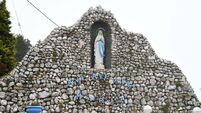Lough Gur bid for World Heritage status
We already have two such sites – Skellig Michael, off the south Kerry coast, and the collection of archaeological treasures around the River Boyne, in Co Meath.
To achieve such a status, a site has to be of “universal” importance and Lough Gur, close to Bruff, is regarded as one of the most important places of its kind in north-west Europe.
Limerick County Council has submitted an application to the Department of the Environment to have Lough Gur included on Ireland’s tentative list of potential World Heritage sites. Already on that list, for example, is Killarney National Park.
Lough Gur is 20km south of Limerick city in the heart of Ballyhoura country. The site includes stone circles and standing stones, age-old burial chambers and cairns and Neolithic house sites dating back over 4,500 years.
The granting of World Heritage Site status would not only help attract additional tourists to Lough Gur, it would also ensure the conservation of the ancient settlement site for future generations.
In recent years, Lough Gur has become an increasingly popular place to visit, especially since the provision of a public recreation and parking area and the opening of a visitor centre by Shannon Development in 1981, which interprets the archaeological, natural and social history of the area.
However, the area has not reached its full potential as a regional, national and international visitor destination, according to Limerick County Council chairman John Gallahue.
The lake is the largest inland water body in Limerick and is surrounded by 130 above ground sites – 28 of which are designated national monuments – linking people with the land over thousands of years. A large number of natural habitats are also in the area, including a eutrophic lake, reed and sedge swamps, a quaking bog, woodland and grasslands.
Such attractions draw thousands of visitors – a trend that’s almost certain to continue with the growing popularity of home holidays and which brings into sharp focus the need to manage the site and the impact of visitors on it.
Much of the land around the lake is made up of working farms. Additional visitors will have implications for the farms in relation to people going onto private property, disturbance of farm animals and other practical matters.
An environmental management plan is currently being conducted in the area, involving a public consultation process, so as to ensure the needs of the local population are taken into account.
Local people have a huge amount of local knowledge and insights that can only enhance the management and conservation of such sites.
The high concentration of so many exceptional archaeological sites spanning thousands of years gives Lough Gur its distinctiveness as a potential World Heritage location, according to Ruairi Deane, tourism product development executive, Shannon Development.
“In recent years, this sensitive area has been under threat from competing demands and it had become apparent that a major multi-disciplinary study of Lough Gur was required to formulate an effective developmental strategy,” he pointed out, adding that the plan is to enhance the area as a high quality visitor destination.
The World Heritage List includes 878 properties in 141 countries, which the World Heritage Committee considers as having outstanding universal value. They include monuments and landmarks as diverse at the Great Wall of China, the Great Barrier Reef, the Sydney Opera House, Machu Picchu in Peru, and the historic centres of famous cities such as Venice, Prague, Rome and Paris.
For a site to qualify, extremely strict criteria have to be met. It has, for instance, to represent a “masterpiece of human creative genius”, bear a “unique or at least exceptional testimony” to a cultural tradition, has to contain “superlative natural phenomena”, or be an area of exceptional natural beauty and aesthetic importance.
As regards our two designated World Heritage sites, the Bru na Boinne complex is known throughout the world, while there’s no doubting the uniqueness of Skellig Michael, a steep, rocky island with well-preserved monastic remains dating to the early centuries of Christianity in Ireland.
The larger of the two Skellig Islands and lying 15km from the mainland, it was an important centre of monastic life for 600 years.
As well as Lough Gur and Killarney National Park, our tentative list of applicants for World Heritage status also includes Clonmacnoise, western stone forts, the Rock of Cashel, Clara Bog, in Co Offaly, the Burren, Co Clare, and the Ceide Fields, in Co Mayo.













